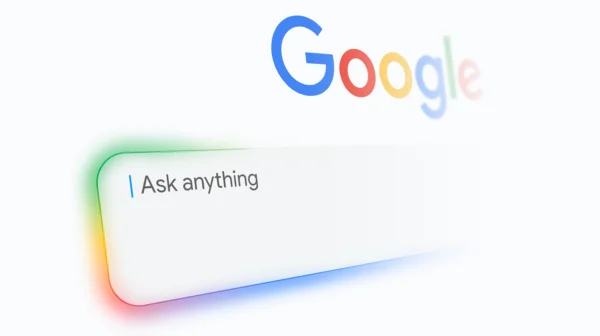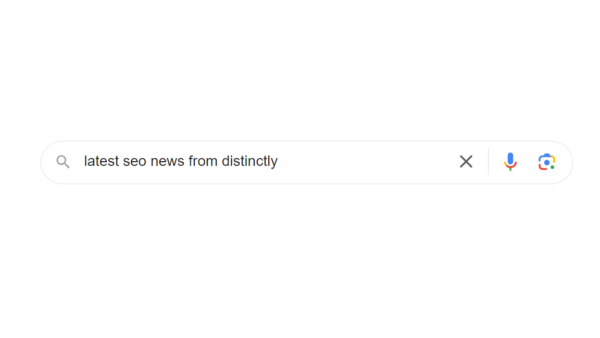Latest organic search news – September 25
We’ve compiled the essential updates from Google and the broader world of search from the last month – keeping you up to date with everything you need to know.
TL;DR
- Can LLMs actually see your content? A new Chrome extension, AI Eyes, shows which parts of your site are hidden from LLMs – worth testing your key pages.
- Which bots can access your site? Max Braglia’s AI Bot Analyzer makes it simple to see which bots are blocked by robots.txt or settings.
- Freshness confirmed as a key ranking factor in ChatGPT. Config files reveal GPT-5 explicitly favours new or recently updated content.
- The case for continuous optimisation. As Jono Alderson puts it: You can sit perfectly still and still be swept miles off course.
- A content marketing playbook for the LLM era. Ryan Law (Ahrefs) shares strategies that mirror SEO but also go wider: citations, research, and off-page activity.
- How to actually monitor LLM visibility. Tools like Peec.ai and Profound show who’s surfacing, which sources matter, and what narratives are forming.
- Not all clicks are created equal. Branded clicks can be worth 3X non-branded ones – keeping brand demand high is critical to performance.
- YouGov’s ‘Media Consumption in Britain 2025’ whitepaper. Social habits are shifting – Reddit and YouTube are climbing, while X continues to decline.
- Buzzstream’s new ListIQ feature. A handy plugin to speed up digital PR prospecting and outreach.
Can LLMs actually see your content?
It’s going to be increasingly hard to surface yourself and your content in LLM results if bots can’t actively see what’s on the page.
A new Chrome extension, AI Eyes, makes it easy to see just how much content isn’t visible to LLM crawlers – and crucially, exactly which bits are hidden. While JavaScript toggling and content visibility testing isn’t new, this tool is one of the first that highlights the precise areas being missed.
Definitely worth downloading and running across your key pages. If important text is being hidden, it may mean LLMs like ChatGPT are missing content that you assumed was crawlable – and that could impact whether you’re surfaced in grounded responses.
Which bots can access your site?
Another handy tool that popped up this month is AI Bot Analyzer from Max Braglia. It quickly checks which bots can access your site or specific pages – and which ones are being blocked.
It’s simple, quick, and worth five minutes of your time. Just drop in your key URLs and you’ll get a clear view of whether LLMs (and other crawlers) can actually see your important content. If your robots.txt or other settings are unintentionally blocking them, that could be cutting you off from visibility in grounded LLM responses.
Freshness confirmed as a key ranking factor in ChatGPT
As discussed in recent roundups, freshness is one of the biggest signals when it comes to being surfaced in ChatGPT results. A new deep-dive from Metehan Yeşilyurt into ChatGPT’s configuration files confirms it: use_freshness_scoring_profile: true is hard-coded into the way GPT-5 ranks sources.
In other words, ChatGPT isn’t just looking at relevance – it’s actively prioritising new or recently updated content. This mirrors what we’ve always seen from an SEO and CRO perspective: fresh content tends to perform best. The difference now is that GPT is openly telling us the same thing.
Why this matters for content creators:
If you’re relying on evergreen content alone, it’s time to rethink. Fresh, recently updated pages have a clear advantage in making it into ChatGPT’s answers – but freshness isn’t just about producing new content to plug gaps. The bigger priority is keeping your most commercially important and EEAT-critical pages alive and relevant. Neglecting older, high-value assets could mean they slip out of both search and LLM visibility, even if they’re still central to your business. This is key to our content approach at Distinctly as we enter the final phase of the year.
Quick tip:
- Start by auditing your commercially important and EEAT-critical pages by their ‘last updated’ date.
- Anything older than 6–9 months that you still deem as relevant and important? Refresh it first.
- Adding FAQs, or answering semantically relevant questions naturally within the content is a quick win, especially if you can incorporate query fan-outs.
- Use the refresh as an opportunity to weave in long-tail queries the page already ranks for.
- For informational content, add “Published on” and “Reviewed on” dates at the top of the pages.
The case for continuous website evolution
Jono Alderson’s latest, Standing Still is Falling Behind, is another great read and aligns with a question we often get asked as SEOs: “Do we always need to do SEO?”
The short answer: yes. If staying visible in competitive SERPs matters, stopping SEO almost always leads to decline. Google becomes accustomed to the pace of evolution on your site – the cadence of updates, new content, how people are talking about your brand. Slow that down, and it risks looking like neglect.
As Jono puts it:
“…the internet isn’t a museum. It’s a coral reef – a living ecosystem in constant flux. Currents shift. New species arrive. Old ones die. Storms tear chunks away. You can sit perfectly still and still be swept miles off course.”
More importantly, you can be sure your competitors are doing the opposite: evolving, publishing, optimising. In that context, “standing still” isn’t neutral – it’s actively falling behind.
Why this matters:
If being visible for the searches your potential customers are making is a business priority, then your website has to evolve continuously. Regular updates, new content, and optimisations aren’t a nice-to-have; they’re the price of maintaining visibility.
Quick tip:
Think of SEO less as a project with an end point, and more like an ongoing evolution – protecting past gains and keeping pace with shifting search landscapes and rival activity.
A content marketing playbook for the LLM era
Strategies for maximising visibility in LLMs are, at times, very similar to SEO – and in other ways, quite different. We’re constantly testing tactics at Distinctly, and in August Ryan Law of Ahrefs posted on X a bit of an LLM playbook which aligns with much of what we’re doing here.
Some key takeaways from his post:
- Visibility in AI is off-page SEO. Brand presence in LLM results isn’t just about your site, but about being cited across respected domains. Guest posts, UGC platforms, podcasts, and co-marketing all matter more than ever.
- Refresh your “most cited” pages. Identify which pages LLMs surface most, and ensure they’re accurate, up-to-date, and highlighting your latest features/research.
- Create the content LLMs prefer. Stats roundups, expert quotes, comparisons, and original research are particularly valuable because they get cited and reused.
- Close competitor gaps. Find out where rivals are cited but you’re not, then create content and promote to fill those holes.
- Bet on emerging topics early. Build out subtopic clusters and query fan-outs before competitors do.
- Invest in proprietary research. If you want to be cited, publish what nobody else has.
- Multimedia and personal brands. Short-form video, YouTube presence, and encouraging your team to build their own voices on social all feed into brand authority. We call this 360 search at Distinctly.
- SEO ≠ just SEO anymore. The future of content visibility blends PR, brand marketing, influencer marketing, and research distribution.
Why this matters:
Content marketing in the LLM era isn’t just about keyword targeting or publishing cadence – it’s about being the source. The more your brand shows up across trusted, external domains (and in formats LLMs favour), the more control you’ll have over how you’re represented in AI-driven answers.
How to actually monitor LLM visibility
Whilst LLM referral traffic still only makes up around 1–2% of total website traffic for most of our clients, we know a common user pattern is to begin with ChatGPT as part of the research process and then return to Google for further analysis – often with brands in mind. This isn’t something that can be directly tracked, but it’s happening across all sectors, particularly among younger demographics.
That makes visibility for target queries in LLMs increasingly important. Over the past two months I’ve been trialling two of the leading tools in this space – Peec.ai and Profound. A deeper write-up will follow, and whilst the science may not be perfect, these tools give a view into how you are being surfaced in LLM answers, along with a lot of useful data around the citations being used when compiling an answer, which can influence your own strategies… These platforms can help you understand:
Your visibility: how often you’re cited in AI-generated answers, and for which prompts.
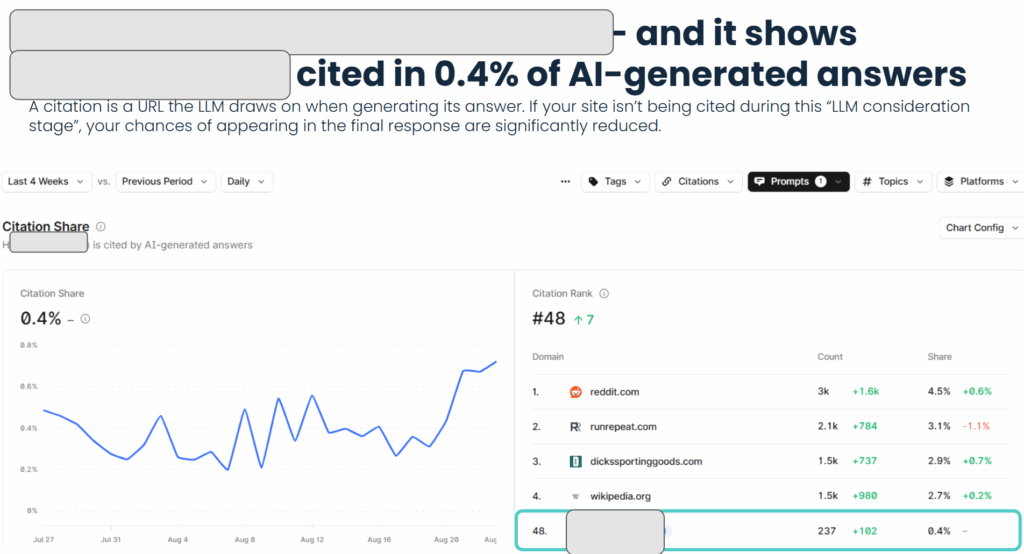
Where citations come from: almost all are earned (in this prompt set) rather than owned, reinforcing the importance of PR, partnerships, and content placement.

Narratives & sentiment: whether LLMs frame your brand positively, or if recurring negatives risk becoming reinforced. Once you know this, you can counter it.

Competitive benchmarking: which brands dominate your category, and how you compare.
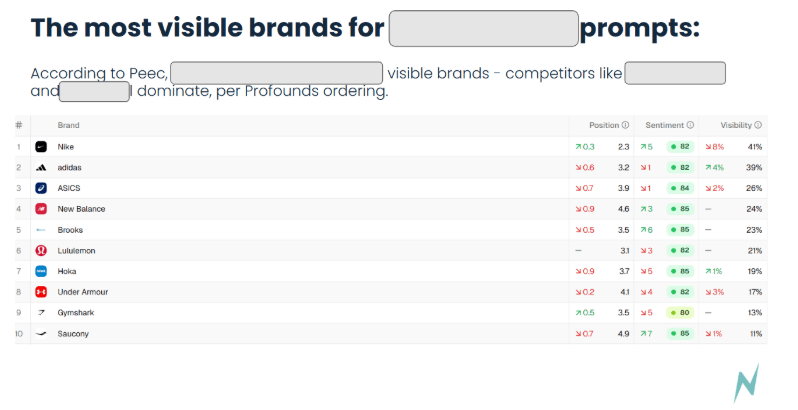
Query-level insights: drilling into specific prompts highlights exactly which brands are most visible and how sentiment skews.
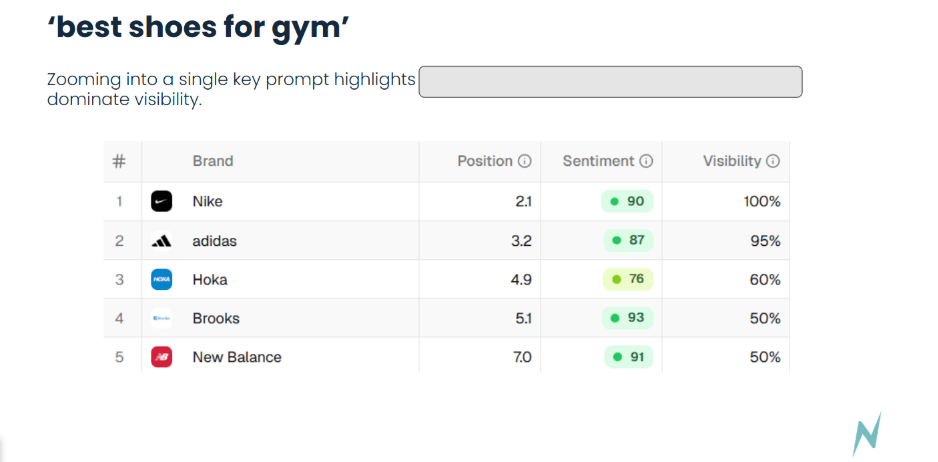
Content gaps: competitor informational pages that get cited most often for target prompts, where your own content may be absent. A simple starting point for a content strategy.

Influential YouTube content: LLMs ingest video data too, and fresh reviews from creators are highly represented.

Top cited URLs: a clear roadmap of non-commercial rivals or publishers you may want to partner with or place content on.

The key takeaway? Most citations are earned. If you’re not appearing on influential third-party sites, you’re unlikely to feature in LLM responses – no matter how strong your owned content is.
The above grabs are from a recent presentation delivered to a client as a standalone LLM visibility report. Please get in touch with me or Distinctly if this is something you want to hear more about.
Not all clicks are created equal
In August, Snr. SEO Manager Cam Sykes did some thought-provoking analysis for one of our clients, around the differing values brand and non-branded clicks have to website performance.
Everyone knows branded traffic converts better. What’s more valuable is being able to quantify the difference – to put a number on how much more a branded click is worth compared to a non-branded one. In one client case, a branded click was worth roughly 3x the value of a non-branded click.

This is really important to understand when we think about the role brand has in organic success and the need for businesses to ensure they are keeping awareness as high as possible, due to the impact it can have on website performance if this drops.
It then leads on to the fact that as digital marketers we can help with the improvement of brand awareness, visibility and clicks – and that actually there may be some low-hanging fruit here if this is something not actively being pursued by businesses, or if there is room for further support/growth.
This again ties in with our 360 Search offering and how we need our clients to be as visible as possible across as many touchpoints as possible, across all the platforms their customers hang out on and offline – and by being constantly present, you drive up brand awareness and signals by proxy.
Additionally, this ties in to what we were talking about earlier in the post about the importance of LLM visibility, and how searchers are likely to take recommendations back onto Google and search for the brands in question.
In short: branded demand is one of the strongest levers in organic performance. Understanding the true value of those clicks – and actively investing in ways to grow them – can have a bigger commercial impact than chasing incremental non-brand traffic.
Quick tip:
- Audit your branded vs non-branded click mix.
- Model the conversion value difference between the two.
- Build strategies to actively grow branded demand – from PR and social through to LLM visibility.
YouGov Releases ‘Media Consumption in Britain in 2025’ whitepaper
A YouGov study released in August has analysed how Brits are using social media in 2025, and a big takeaway from the report is that there are clear shifts in platform growth and audience behaviour – highlighting just how important it is that digital PR strategies shift with this movement too.
- Reddit usage in the UK is up significantly (16% MoM), with British social media users more likely to use Reddit than the average, especially amongst Gen Z and Millennials
- YouTube is the most likely platform to have seen increased usage year-on-year, with 28% of social media users saying they use it more now than last year
- In contrast, X (formerly Twitter) has had a steep decline in users – 41% say they use it less now than a year ago
For brands, the digital PR opportunity increasingly lies in platforms that are on the rise (YouTube, Reddit, Instagram, TikTok), which means that campaigns that can cross channels onto video-first platforms on YouTube, or generate community-driven engagement on Reddit, are likely to see stronger traction.
With the rising use of LLMs, we also know that a lot of insights are drawn from community-driven platforms like Reddit and Quora, so campaigns appearing here are also a big win for visibility.
All to say, earned media no longer lives in isolation. Digital PR strategies are shifting to ensure coverage is being re-shared, discussed, and debated on platforms where users are actively seeking authentic voices and peer validation.
Buzzsteam’s new ListIQ feature
BuzzStream recently rolled out ListIQ, which we’ve been testing here at Distinctly. It’s a handy tool for digital PRs that you can install as a plugin and use alongside your Buzzstream account. Designed to help identify and organise outreach opportunities, it’s great for quickly seeing who might be worth connecting with when pitching relevant stories.
It doesn’t replace the creative side of DPR work, but it does help to make the outreach process more streamlined.
Stay ahead in SEO with Distinctly
Enjoyed this roundup? Stay updated with the latest Organic trends, tips, and exclusive insights by subscribing to our newsletter.

